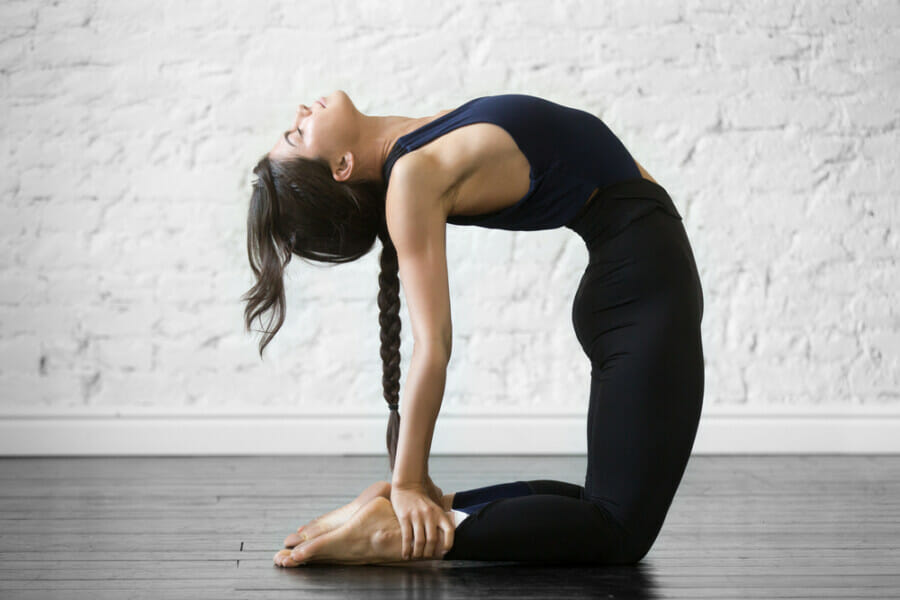Benefits Of Ustrasana Or Camel Pose In Back Pain, Constipation And Rounded Shoulders
Many yoga poses offer significant advantages such as downward dog, savasana, and cat-cow pose. Another beneficial pose to incorporate into your yoga practice is Ustrasana, commonly known as camel pose. This heart-opening backbend not only feels delightful but also proves beneficial, especially after long hours of being seated at a desk or in front of a computer, according to Sabrina Washington, a CorePower Yoga instructor in Sacramento, California. It serves as a wonderful transitional exercise as you prepare to unwind for the day. Read on to discover the benefits of camel pose, along with step-by-step instructions on how to perform it and the precautions to bear in mind.
Ustrasana or camel pose benefits
1. Stretches and strengthens
Camel pose not only provides an excellent stretch but also helps strengthen various muscle groups such as the abs, thighs, back, hamstrings, and glutes, as mentioned by Washington.
2. Corrects rounded shoulders
Many individuals tend to slouch over electronic devices or steering wheels for prolonged periods, leading to issues such as rounded shoulders and upper back pain. Camel pose can counteract these effects by opening up the chest and realigning the spine in the opposite direction, helping alleviate accumulated pain and strengthening the spine.
3. Helps with back pain
In addition to addressing rounded shoulders, camel pose can assist in preventing back pain by engaging and strengthening the muscles in the back and abdominals, which are crucial for maintaining proper posture and a strong core.
4. May relieve constipation
This pose can potentially aid in relieving constipation by stretching the abdominal region, stomach, and intestines, thereby promoting healthy digestion.
5. Opens up your chest
Camel pose serves as a heart-opening backbend that can enhance breathing capacity and foster feelings of joy, love, and compassion. Performing heart-opening poses like this may evoke vulnerability or emotional responses in some individuals, and it is important to approach them gently and at your own pace.
6. Cultivates a sense of inner harmony
Engaging in Ustrasana generally imparts a sense of calm, empowerment, and strength to practitioners. Some may find this pose particularly relaxing, aiding in reducing overall stress and anxiety levels to promote inner peace.
How to do the Ustrasana or camel pose
When practicing camel pose, it is essential not to push yourself too far into the backbend. Focus on finding a comfortable backbend that allows you to breathe deeply for about 30 seconds, advises Washington.
Begin by kneeling at the center of your mat with your knees directly under your hips. Place your hands on your lower back with fingers pointing downwards. Inhale and lift your chest towards the ceiling, creating a C-curve in your back. Hold this position for around 30-60 seconds or proceed further by engaging your thighs and glutes, bringing your hands to your heels while keeping your hips over your knees and your chin tucked.
To exit the pose, place your hands back on your hips, engage your core, and slowly lift your chest back up. Finally, take a few breaths with your hands on your thighs to stabilize and calm yourself.
Remember to listen to your body and exit the pose safely, recommends Washington.
Ustrasana precautions
While camel pose offers numerous benefits, it is advisable to avoid this pose if you are injured, recovering from surgery, or have chronic knee, shoulder, neck, or back issues. Consult with a healthcare professional before attempting this intermediate pose to prevent exacerbating any existing conditions.
Some individuals may experience headaches post backbends. To minimize this risk, consider incorporating camel pose towards the end of your yoga sequence or begin with cat-cow stretches to warm up your body adequately. Breathing mindfully throughout the pose and avoiding breath-holding can also help prevent headaches and facilitate a safer practice.
Washington emphasizes the importance of using your breath as a guide during Ustrasana to maintain a controlled and comfortable backbend, ensuring a positive and beneficial yoga experience.














